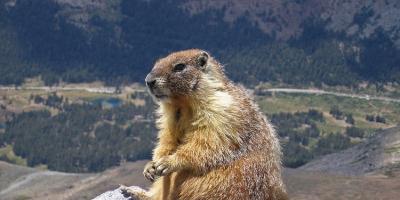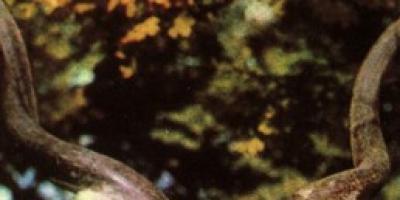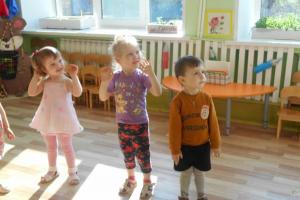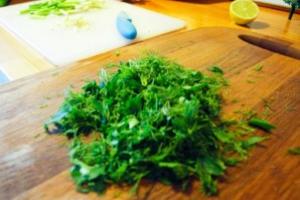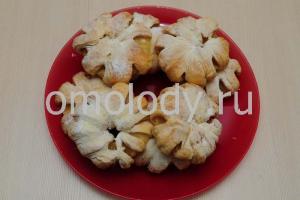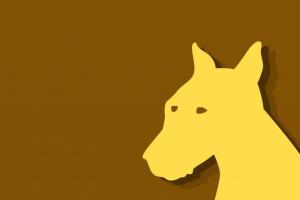Dealing with a microorganism is not easy. People are trying to find means that could completely eliminate tick activity. Therefore, not only medicinal formulations are used, but also folk remedies.
Plant characteristics
Leafless Anabasis is known to many as barnyard grass. It can be recognized by its underdeveloped leaves, which are practically absent.
There are several types of plants:
- saline;
- Syrdarya;
- leafless.
The latter has the greatest beneficial properties.
Another name for anabasis is barnyard grass
Grass grows on salt marshes and sands. Large clumps of anabasis usually grow. You can meet it in the Asian part of the world, Transcaucasia and the southeast of the European part of Russia.
Anabasis has a rich composition, which determines its beneficial features. The main substances are alkaloids, which are used in classical medicine in medicines, as well as folk decoctions and infusions.
Among the useful alkaloids are:
- anabasine;
- aphylline;
- affillidine;
- lupinin;
- oxyaphylline.
The plant is most rich in anabasine. It is a strong poison if used in its pure form. However, when used correctly, it helps cope with various diseases.
Beneficial effects
Traditional healers have long been studying the beneficial properties of anabasis. They noted that it can only be used externally. This is due to the fact that the grass is considered poisonous.
Treatment of affected areas of the skin is carried out for some diseases. The solution has:
- anti-mite;
- antifungal;
- bactericidal actions.

The plant extract penetrates deep into the tissue, therefore eliminating even tick larvae
Anabasis contains:
- antioxidants;
- antifungal components;
- antiradical elements.
Like any folk remedy, Anabasis is not a miracle plant. Therefore, during treatment it is necessary to combine it with other drugs.
Features of application
Anabasis leafless is used by folk healers as a remedy that helps fight demodicosis. There are two options for using the plant: in the form of an alcohol tincture and a decoction.
To prepare a composition without alcohol, add anabasis leaves to a saucepan. They are filled with water and placed on fire. The composition must be evaporated for 10 minutes.
The product must be wiped over the affected skin 2-3 times a day. If the decoction is used for washing, then the duration of treatment is limited to complete recovery.
An alcohol tincture of the herb is also considered effective. To prepare it at home, you need to mix part of anabasis with two parts of ethyl alcohol (70%). The composition must be infused for four days. After filtering, the product is poured into a separate container. It is worth remembering that the plant is poisonous. Therefore, the jar is signed and put away in an inaccessible place.
The use of alcohol tincture is allowed only externally. Mite-affected areas should be wiped twice a day. Improvements can be noticed after 10–12 days.
If you use an alcohol tincture, you should be extremely careful. After all, there is a high probability of getting a chemical burn. Therefore, after applying the composition, you need to wash your face no later than an hour.

The herb is saturated with poison, so it should be used with extreme caution
Contraindications and precautions
The plant is very poisonous. This is due to the strong poison anabasine included in the composition. If it penetrates through the skin, poisoning of the body can occur. For death, no more than 3 drops will be required.
Poisoning can be recognized by several symptoms. Among them are:
- copious flow of saliva;
- vomiting;
- dizziness;
- increased heart rate;
- increased breathing.
If there is severe damage to the body, then these signs are accompanied by delirium, convulsive syndrome, cold sweating and slow breathing.
If such signs appear, it is necessary to rinse the stomach or take vomiting agents. After this, the use of sorbents is indicated. Some patients undergo cardiopulmonary resuscitation.
The following are used as medicines:
- symptomatic drugs;
- saline laxatives;
- solutions for cleansing enemas.

When using a decoction or alcohol tincture, a positive result occurs very quickly
Dealing with a microorganism is not easy. People are trying to find means that could completely eliminate tick activity. Therefore, not only medicinal formulations are used, but also folk remedies.
Plant characteristics
Leafless Anabasis is known to many as barnyard grass. It can be recognized by its underdeveloped leaves, which are practically absent.
There are several types of plants:
- saline;
- Syrdarya;
- leafless.
The latter has the greatest beneficial properties.
Another name for anabasis is barnyard grass
Grass grows on salt marshes and sands. Large clumps of anabasis usually grow. You can meet it in the Asian part of the world, Transcaucasia and the southeast of the European part of Russia.
Anabasis has a rich composition, which determines its beneficial properties. The main substances are alkaloids, which are used in classical medicine in medicines, as well as folk decoctions and infusions.
Among the useful alkaloids are:
- anabasine;
- aphylline;
- affillidine;
- lupinin;
- oxyaphylline.
The plant is most rich in anabasine. It is a strong poison if used in its pure form. However, when used correctly, it helps cope with various diseases.
Beneficial effects
Traditional healers have long been studying the beneficial properties of anabasis. They noted that it can only be used externally. This is due to the fact that the grass is considered poisonous.
Treatment of affected areas of the skin is carried out for some diseases. The solution has:
- anti-mite;
- antifungal;
- bactericidal actions.

The plant extract penetrates deep into the tissue, therefore eliminating even tick larvae
Anabasis contains:
- antioxidants;
- antifungal components;
- antiradical elements.
Like any folk remedy, anabasis is not a miracle plant. Therefore, during treatment it is necessary to combine it with other drugs.
Features of application
Anabasis leafless is used by folk healers as a remedy that helps fight demodicosis. There are two options for using the plant: in the form of an alcohol tincture and a decoction.
To prepare a composition without alcohol, add anabasis leaves to a saucepan. They are filled with water and placed on fire. The composition must be evaporated for 10 minutes.
The product must be wiped over the affected skin 2-3 times a day. If the decoction is used for washing, then the duration of treatment is limited to complete recovery.
An alcohol tincture of the herb is also considered effective. To prepare it at home, you need to mix part of anabasis with two parts of ethyl alcohol (70%). The composition must be infused for four days. After filtering, the product is poured into a separate container. It is worth remembering that the plant is poisonous. Therefore, the jar is signed and put away in an inaccessible place.
The use of alcohol tincture is allowed only externally. Mite-affected areas should be wiped twice a day. Improvements can be noticed after 10–12 days.
If you use an alcohol tincture, you should be extremely careful. After all, there is a high probability of getting a chemical burn. Therefore, after applying the composition, you need to wash your face no later than an hour.

The herb is saturated with poison, so it should be used with extreme caution
Contraindications and precautions
The plant is very poisonous. This is due to the strong poison anabasine included in the composition. If it penetrates through the skin, poisoning of the body can occur. For death, no more than 3 drops will be required.
Poisoning can be recognized by several symptoms. Among them are:
- copious flow of saliva;
- vomiting;
- dizziness;
- increased heart rate;
- increased breathing.
If there is severe damage to the body, then these signs are accompanied by delirium, convulsive syndrome, cold sweating and slow breathing.
If such signs appear, it is necessary to rinse the stomach or take vomiting agents. After this, the use of sorbents is indicated. Some patients undergo cardiopulmonary resuscitation.
The following are used as medicines:
- symptomatic drugs;
- saline laxatives;
- solutions for cleansing enemas.

When using a decoction or alcohol tincture, a positive result occurs very quickly
Anabasis leafless
Or Hedgehog
Poisonous
Lat. Anabasis
The parts used are the overhead part.
 Botanical description
Botanical description
Perennial subshrub, up to 70 cm high. It grows as a flattened spherical bush 55-60 cm (up to 140 cm) in diameter. The root is taproot, curved, thick, woody, powerful, 5–20 m long.
The stems are numerous, annual, branching from the base. There are no leaves; instead, there are short, internally truncated hairy sheaths formed from scales fused in pairs. five-membered bisexual, small and inconspicuous, sitting singly in the axils of blunt bracts, forming dense strip-like inflorescences. There are 5 stamens, a pistil with an upper, single-locular ovary and 2–3 short and thick stigmas. The fruits are juicy, round, laterally flattened, single-seeded, with a fleshy pericarp, with one vertically located seed. When fruiting, rounded kidney-shaped yellowish or slightly pinkish wings develop.
Leafless Anabasis (Ezhovnik) grows on the flat territory of Kazakhstan, in the republics Central Asia, Azerbaijan and the southeastern regions of the European part of Russia. It grows on plains and low foothills, on clay and loamy saline soils of deserts and semi-deserts. The densest thickets of anabasis are located in river valleys, where groundwater They lie at a depth of 3-6m and at the boundaries with sand, where groundwater wedges out. The good condition of the anabasis thickets indicated to the nomadic Kazakhs that it was in this place that they needed to dig a well.
Anabasis reproduces by seed. From the second year, its specimens regularly bloom and bear fruit. Anabasis is characterized by the ability to regenerate, thanks to which lost parts of the plant are quickly restored.
Active ingredients
Alkaloids - anabasine, aphylline, aphyllidine, lupunine, oxyaphylline, oxyaphyllidine, saponins, alkaloids. The seeds contain saponins, alkaloids, anabasine, lupinine, aphylline, oxyaphylline, aphyllidine, oxyaphyllidine, aphyllic acid methyl ester.
Collection and preparation
The most favorable period for procuring anabasis raw materials is from June to September. When harvesting, cut off the above-ground part at the base of the branching bush and put it in small stacks to dry at the collection site. A sign of sufficient dryness is the fragility of the branches (poorly dried branches do not break, but bend). Plants dried in this way are threshed and then passed through screens (sieves).
Healing effect and application
Anabasine hydrochloride (gamibazin) in the form of tablets and chewing gum is approved for use as a means of reducing the tendency to smoke and alleviating the painful condition of smokers.
In Central Asia, a decoction of anabasine roots is used for pulmonary tuberculosis, and the powder of the stem is used for skin diseases, for powdering wounds and ulcers.
It is used in the national economy to control crop pests of a wide variety of plants.
Anabasine preparations act as a contact poison and are used by spraying and dusting; anabasine sulfate is successfully used for disinfection planting material, especially citrus crops.
In veterinary medicine, an aqueous extract of anabasis is used for skin diseases of livestock. The meal is used for fertilizer and fuel. The ash is used for the artisanal processing of wineskin leathers and for the production of soda and potash.
Contraindications
The plant is poisonous and should not be used independently without the advice of a doctor. Two or three drops of anabasine count lethal dose for a person.
Anabasis leafless is a succulent (a plant capable of storing moisture in special tissues) of the Chenopodiaceae family, a flattened spherical shrub reaching a height of up to 75 cm.
He is called:
- leafless anabasis;
- Leafless barnyard grass.
All plants on Earth have certain properties that make them useful to humans. It doesn't depend on them appearance. They may be attractive or repulsive, but useful qualities this does not reduce them. One of the unsightly but needed by a person plant is barnyard grass.
Description of the plant
It has a hard, woody rhizome that can reach a depth of 20 m from the soil surface in search of moisture and nutrients. From the very base, the stems of anabasis branch into cylindrical, smooth, succulent shoots. The leaves are in the shape of triangular scales, arranged in pairs, but have no chlorophyll and are undeveloped. Inflorescences in the form of spikelets crown the shoots. The growth of green shoots occurs from April to the end of July, after which the time of flowering begins. Lost shoots are regenerated very quickly.
Leafless Anabasis can be found in the south of Russia, Kazakhstan, Central Asian countries and Azerbaijan. Industrial procurement is possible only in the Kzyl-Orda region of Kazakhstan. The plant is poisonous, so taste qualities there is no need to judge escapes.
Compound
Only the green part containing whole line alkaloids: anabasine, aphylline, lupunin, oxyaphylline, oxyaphylline, as well as organic acids. N Icotinic acid, obtained from the plant, is used to treat the liver, fight spasms and get rid of non-healing wounds. However, it is anabasine that has the greatest value in medicine.
Properties used in medicine
Anabasine has properties similar in its effect on the human body to the properties of nicotine and lobeline. A popular pharmacological agent is hydrochloride, a drug that reduces the need to smoke tobacco. Often called "Gamibazin". Available in the form of small tablets, polymer films coated with the drug and chewing gum containing anabasine.
Small tablets are placed under the tongue and dissolved. After resorption, it feels like smoking 5-6 cigarettes. The first doses may cause slight passing nausea. The daily dose should not exceed 8 tablets. The effectiveness of the product is very high. Even a heavy smoker will quit smoking completely after ten days of taking it.
A polymer film with anabasine is fixed on the gums or on the inner mucous membrane of the cheek. About eight of these films can be used during the day.
Gamibazin gum is used for the first 5 days, no more than four pieces per day, and then the number of gum is reduced.

IN folk medicine Barnyard grass is used as a remedy for tuberculosis and helps heal wounds. But the main use of this plant is in industry for the synthesis of the substances it contains, as well as for the production of a strong contact insecticide.
Recipes
The scope of use of the plant is severely limited due to its high toxicity.
However, there are several relatively accessible recipes that help in the treatment of quite serious diseases.
- The powder of the dried plant is used as a powder for long-term non-healing wounds and ulcers.
- Vodka tincture helps with demodicosis: the affected areas are smeared with it twice a day.
- Folk healers use a weak decoction of the roots to treat tuberculosis.
Contraindications
The plant is extremely poisonous: the effect of anabasine is similar to nicotine, it is also
belongs to the group of curare-like poisons.
Contact with skin can cause severe poisoning, and 2-3 drops of the substance inside can be fatal.
Leafless Anabasis - Anabasis aphylla L.
Chenopodiaceae family - Chenopodiaceae
Other names:
- leafless barnyard grass
Botanical characteristics. Succulent subshrub 25-75 cm high. Grows as a flattened spherical bush 55-60 cm (up to 140 cm) in diameter. The rhizome is thick, curved, woody, turning into a powerful main root, which often penetrates to the depth of pound water (5-20 m). The root system is taproot. The stems are numerous, woody in the lower part, branching from the base. Branched, green, sometimes bluish, juicy, smooth, cylindrical segmented shoots extend oppositely from the lignified lower part of the stem. The segments are the internodes of the stem. The leaves are almost undeveloped; scaly, barely noticeable, obtuse, broadly triangular, merging at the nodes of the stem in pairs into short, internally hairy sheaths. The leaves are devoid of chlorophyll: the function of assimilation is performed by annual stems.
Five-membered bisexual small inconspicuous flowers (up to 2.5 mm long) sit one at a time in the axils of blunt bracts, forming rather dense spike-shaped inflorescences at the ends of the branches. The fruits are round, laterally flattened, single-seeded, winged, with a fleshy pericarp.
Herbaceous shoots on the anabasis bush grow from April to July, then flowering begins. The preservation of thickets of anabasis, despite the massive collection, is largely due to the ability of the plant to quickly grow the above-ground part.
Spreading. Leafless Anabasis is an eastern Mediterranean species, penetrating east to the Mongolian Altai. It grows on the flat territory of Kazakhstan, in the republics of Central Asia, Azerbaijan and the south-eastern regions of the European part of Russia. The main areas of industrial procurement are South Kazakhstan, Dzhambul and Kzyl-Orda regions.
Habitat. This is a plant of plains and low foothills, which does not rise to mountains above 400 m above sea level. It grows on clayey and loamy saline soils of deserts and semi-deserts, on takyrs, gray soils, solonetzes, and less often on saline soils. It reacts positively to loosening of soil and ground, as can be judged by the abundant and lush growth of anabasis in plowed areas and emissions from rodent burrows. It is not found on sandy soils, but on takyrs it easily tolerates shallow sand cover.
Preparation. The most favorable period for procuring anabasis raw materials is from June to September. Raw materials are harvested manually (using a sickle) or with special units, cutting off the upper parts of shoots 20-25 cm long.
Security measures. To avoid depletion of the thickets, it is necessary to leave about 1/3 of the total number of shoots intact on each bush. After 3-4 years (maximum after 5 years) of harvesting, each array must be given rest, i.e., no harvesting should be carried out on it. After this, it is advisable to rejuvenate the thicket in winter. Rest of a plot once every 3-5 years may not be sufficient to ensure seed regeneration of anabasis, because not every year is favorable for obtaining good harvest fruits, seed germination and seedling development. Therefore, part of the bushes of each massif should be left annually as seed plants. At manual collection Approximately every tenth plant should be left untouched; during mechanized harvesting, after wearing out each strip 40 m wide, a strip of about 5 m is left untouched.
Drying. The cut shoots are left on the field in small, loosely folded piles, which after 2-3 days are piled into larger heaps. Then the raw materials are taken to the threshing floor, dried and passed through a thresher or silage cutter, dividing the shoots into segments or internodes. After this, the raw materials are sifted through a screen to remove any accidentally introduced impurities, as well as lignified parts.
One anabasis bush produces from 600 to 2400 g of green shoots. The content of alkaloids in the plant during the growing season constantly decreases, but at the same time there is an increase in green mass, as a result of which the yield of anabasine from an individual bush and from a unit area remains approximately the same throughout the entire growing season.
External signs. The raw materials consist of crushed, for the most part herbaceous twigs, 2-4 cm long and about 3 mm thick, broken up into separate segments. The branches are tough, bare, with barely protruding, undeveloped leaves in the form of two membranous scales fused into a sheath. The color of the raw material is gray-green, the smell is weak and peculiar, the taste is not tested - the plant is poisonous.
According to the requirements of GOST 2566-79, shoots of leafless anabasis must contain no less than 1.4% anabasine (calculated on an absolutely dry weight), no more than 12% moisture, no more than 3% organic impurities, and no more than 1% mineral impurities.
Chemical composition. Non-lignified green shoots (grass) of leafless anabasis contain 2-4% (up to 12%) of alkaloids: anabasine, aphylline, aphyllidine, lupunin, oxyaphylline, oxyaphyllidine, etc. The main alkaloid, constituting at least 60% of the sum of bases, is anabasine. This is a liquid alkaloid, in contrast to the accompanying ones (aphylline, aphyllidine, etc.), which are crystalline substances. The grass is rich in organic acids.
Pharmacological properties. Anabasine is similar in pharmacological properties to nicotine, cytisine and lobeline.
Medicines. Anabasine hydrochloride in the form of tablets and chewing gum (gamibazine), films with anabasine hydrochloride. Anabasine sulfate.
Application. Anabasine hydrochloride (gamibazin) in the form of tablets and chewing gum is approved for use as a means of reducing the tendency to smoke and alleviating the painful condition of smokers.
Nicotinic acid, obtained from the anabasis herb by oxidation, is widely used in medicine for pellagra, liver diseases, vascular spasms, sluggishly healing wounds and ulcers, as well as infectious diseases.
Anabasine sulfate is a well-known insecticide.
Anabasin hydrochloride (Anabasinum hydrochloridum). In small doses, anabasine hydrochloride has been proposed as a means of facilitating smoking cessation. For this purpose, the drug is available in the form of tablets, films and chewing gum "Gamibazin".
The tablets contain 0.003 g of anabasine hydrochloride. Use tablets with anabasine hydrochloride orally or sublingually daily, starting with one tablet, 8 times a day (every 2 hours) for 5 days. If the result is positive, continue to use the tablets from the 6th to the 12th day, 1 tablet every 2.5 hours (6 tablets per day), from the 13th to the 16th day - 1 tablet every 3 hours, from On the 17th to 20th day - 1 tablet every 5 hours, from the 20th to 25th day - 1-2 tablets per day. From the first day of taking the pills, you must stop smoking or sharply reduce its frequency and completely stop smoking no later than 8-10 days from the start of treatment. If the desire to smoke does not decrease within 8-10 days, stop taking the pills and make a new attempt at treatment after 2-3 months.
Tablets are contraindicated for atherosclerosis, severe increases in blood pressure, and bleeding. In the first days of taking the pills, nausea may occur, headache increased blood pressure. Usually these phenomena disappear when the dose is reduced. If necessary, stop taking the pills. There are indications that the use of anabasine (in the form of tablets orally or sublingually) can cause toxicoderma.
Films with anabasine hydrochloride (Membranulae cum Anabasino hydrochloridi). Oval-shaped polymer plates of white (or with yellowish tints) color, dimensions 9x4.5x0.5 mm, containing 0.0015 g (1.5 mg) of anabasine hydrochloride. They are also intended for smoking cessation. The film is glued to the gum of the labial part or the mucous membrane of the buccal area every day for the first 3-5 days, 4-8 times. If the effect is positive, treatment is continued according to the following scheme: from the 5th to the 8th day - 1 film 3 times a day, from the 9th to 12th day - 1 film 2 times a day, from the 13th to Day 15 - 1 film 1 time per day. From the first day of treatment, it is advisable to stop smoking or sharply reduce the frequency of smoking. In the first days of using film with anabasine hydrochloride, unpleasant taste sensations, nausea, mild headache, dizziness, and a slight increase in blood pressure are possible. In these cases, you should stop using the drug.
Gamibasin (Gamibasinum). Chewing gum (based on a special chewing mass) containing 0.003 g of anabasine hydrochloride. Rectangular or square elastic band (22x22x8 mm, or 32x22x5 mm, or 70x19x1 mm) of light gray or light yellow color with the smell of food aromatic substances (with added sugar, molasses, citric acid, flavoring, etc.). Is one of dosage forms Anabasine for smoking cessation. Apply by prolonged chewing daily, initially 1 gum (0.003 g) 4 times a day for 4-5 days. If the effect is positive, treatment is continued according to the following scheme: from the 5th - 6th to the 8th day - 1 rubber band 3 times a day; from the 9th to the 12th day - 1 elastic band 2 times a day; subsequently until the 20th day - 1 rubber band 1-2 times a day. Subsequent courses may be repeated.
Possible side effects and contraindications are the same for all dosage forms containing anabasine hydrochloride, as well as lobeline and cytisine.
Nicotinic acid (Acidum nicotinicum). Vitamin RR. Nicotinic acid and its amide are specific anti-pellagric agents, and therefore they are designated as vitamin PP (from "Pellagra-Preventive" - preventing pellagra.). Their use, especially on early stages disease, leads to the disappearance of pellagra phenomena. Nicotinic acid has not only antipellagritic properties; it improves carbohydrate metabolism, has a positive effect on mild forms of diabetes, liver and heart diseases, peptic ulcer stomach and duodenum and enterocolitis, slow-healing wounds and ulcers. It also has a vasodilating effect. Nicotinic acid has lipoproteinemic activity. In large doses (3-4 g per day) it reduces the content of triglycerides and b-lipoproteins in the blood. In patients with hypercholesterolemia, its influence reduces the cholesterol/phospholipid ratio in low-density lipoproteins.
Prescribed as a specific remedy for the prevention and treatment of pellagra. In addition, they are used for gastrointestinal diseases (especially gastritis with low acidity), liver diseases (acute and chronic hepatitis, cirrhosis), vascular spasms of the extremities, kidneys, brain, neuritis of the facial nerve, atherosclerosis, long-term non-healing wounds and ulcers, infectious and other diseases.
Nicotinic acid is used orally (after meals) and parenterally. For preventive purposes, adults are prescribed 0.015-0.025 g orally; children 0.005-0.02 g per day. For pellagra, adults are given 0.1 g orally 2-3-4 times a day for 15-20 days; a 1% solution of 1 ml is administered parenterally 1-2 times a day for 10-15 days. Children are prescribed orally from 0.005 to 0.05 g 2-3 times a day. For other diseases, nicotinic acid is prescribed to adults at 0.02-0.05 g (up to 0.1 g); children - 0.005-0.03 g 2-3 times a day.
As a vasodilator for ischemic stroke, 1 ml of a 1% solution is administered intravenously. Intravenously administered slowly. Subcutaneous and intramuscular injections of nicotinic acid are painful. To avoid irritation, you can use sodium nicotinate (sodium salt of nicotinic acid) or nicotinamide.
Higher doses for adults orally: single 0.1 g, daily 0.5 g; into a vein (in the form of sodium salt): single 0.1 g, daily 0.3 g. When taken orally, a single dose can be gradually increased (in the absence of side effects) to 0.5-1 g, and the daily dose - up to 3 -5 g (mainly in the treatment of atherosclerosis and other lipid metabolism disorders).
Nicotinic acid (especially when taken orally on an empty stomach and in persons with hypersensitivity) can cause redness of the face and upper half of the body, dizziness, a feeling of a rush of blood to the head, nettle rash, paresthesia. These phenomena go away on their own. With fast intravenous administration solutions of nicotinic acid, a strong decrease in blood pressure may occur.
Intravenous injections are contraindicated in severe forms hypertension and atherosclerosis. Persons with hypersensitivity to nicotinic acid should be prescribed nicotinamide, except in cases where nicotinic acid is used as a vasodilator. It should be borne in mind that long-term use of large doses of nicotinic acid can lead to the development of fatty liver degeneration. To prevent this complication, it is recommended to include foods rich in methionine in the diet, or prescribe methionine and other lipotropic agents.
Nicotinic acid is part of the complex preparations "Nikoverin", "Nikoshpan" and is part of the molecules "Xanthinol nicotinate" and "Picamilon". The effect of these drugs is largely associated with vasodilating and other properties

